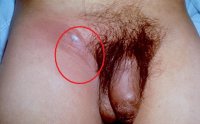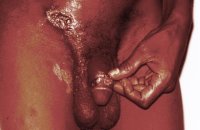Chancroid
Don't be ignorant about this diseaseRisk - any sex with another
Often there are no symptoms
Street names
soft chancre, soft sore, soft ulcer
Facts about chancroid
- Caused by a capsule-shaped bacterium called Haemophilus ducreyi.
- About 4000+ cases in U.S. each year.
- Spread by direct contact with a sore during any sex act.
- Ejaculation not needed to spread infection.
- No mother to baby transmission.
- Not spread by toilet seats or clothes.
Symptoms

- Starts as tender bump on penis, inside or outside the vagina, rectum or anywhere.
- 1-2 days later, the bump becomes a shallow sore that opens and deepens. Becomes painful and full of pus.
- Lymph glands in groin get infected and swell so much they can burst. This swelling is called a bubo. The pus from the sore is infectious.
- Sores may last for weeks and take months to heal.

Treatment
- The correct antibiotic will kill the bacterium. Your doctor determines which antibiotic to use.
- No over-the-counter drugs work.
- Chancroid can occur repeatedly and at the same sites.
Prevention
- Only 100% completely safe option - choose not to have sex!
- Latex condoms help but sores can be on or away from the penis.
Individual help
If you have further questions or concerns about STDs, ask Dr. Mike, an internationally known Clinical Microbiologist specializing in STDs. He has worked extensively with teenage boys and contributed all the information and STD images on the disease pages here.

Copy and paste* jmm8ATcomcast.net into your email client and tell Dr Mike how old you are, what country you are from and then ask your question. You will be emailing a medical specialist offering his time to help young guys. Your email will be treated confidentially and erased after he answers you.
* change AT to @ to make a normal email address format - done this way to prevent automated spam email address harvesting.

